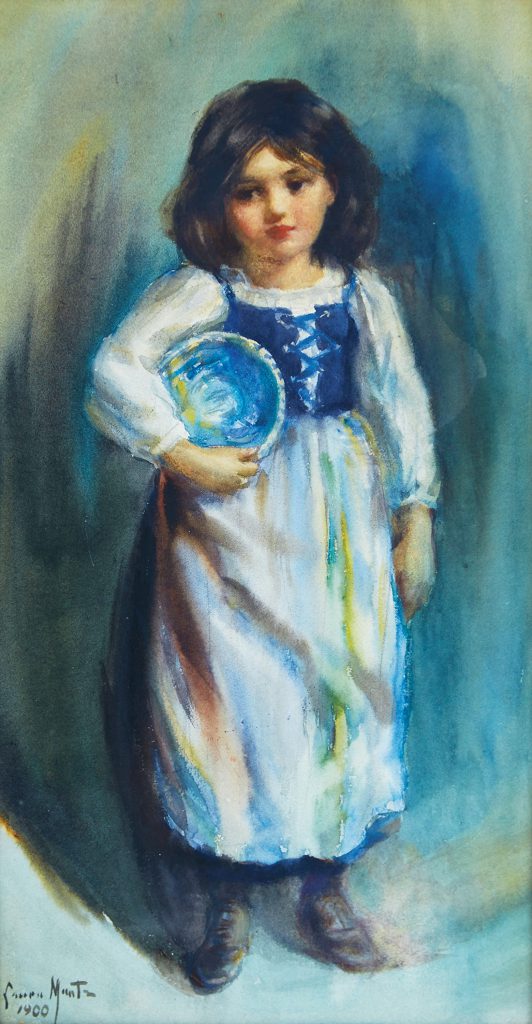Cowley Abbott’s Live Auction of Important Canadian and International Art, taking place on September 24th at the Royal Ontario Museum, includes numerous works by celebrated Canadian female artists. Women artists have had a monumental impact on Canadian art throughout the decades. These accomplished artists have enriched the practice of visual art with their unique voices and distinctive artistic styles, developing an important facet within the Canadian art world. The breadth and talent of these female artists, and their significance in the past, present and future, is essential to the captivating story of Canadian art-making and collecting.
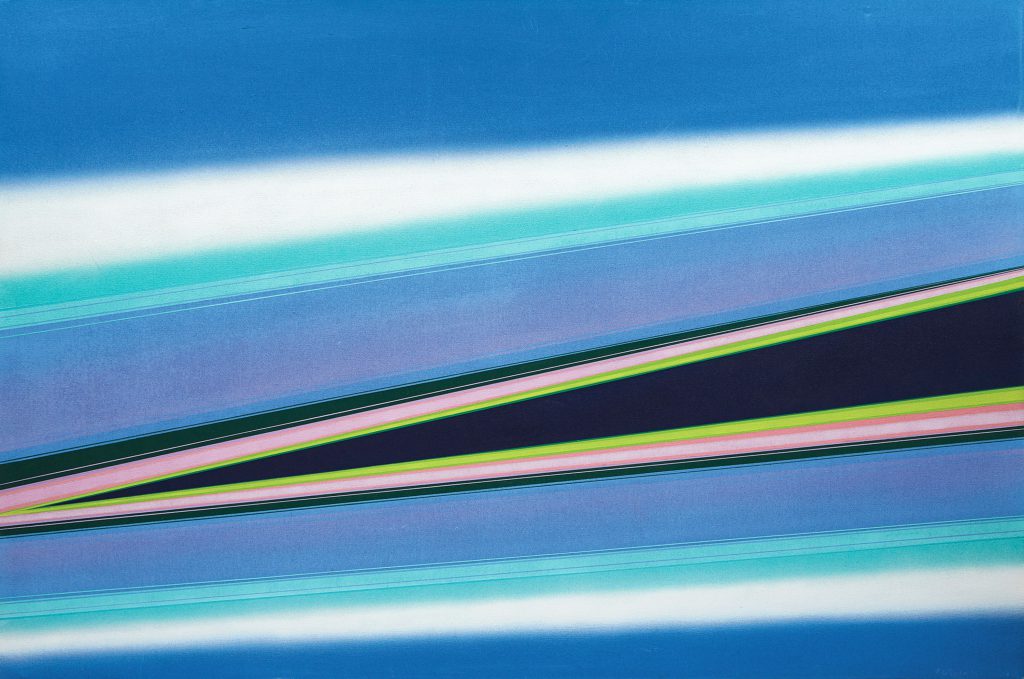
The critically acclaimed Rita Letendre, a prominent abstract artist, born of Abenaki and Quebecois heritage, has had a significant artistic career of various stylistic periods, spanning decades and various geographic placements. Letendre’s career in painting was cemented in Montreal in the 1950s when she became associated with two prominent abstract groups in Quebec, Les Automatistes and Les Plasticiens. Letendre was often the sole female artist within the shows for these groups, and eventually developed away from their approach to painting, finding it too restrictive.
Letendre’s large canvases of the 1970s explore her fascination with depicting speed and vibration. The use of airbrushed paint creates a dimension of depth in “Abstraction” (lot 48), while the dramatic shift in palette occurs when the black ‘arrow’, framed by two vivid neon green and bright pink stripes, constrained by turquoise and azure bands, slices through the surface of the work. The sharp lines of bright colour all converge to a single point at the tip of the black ‘arrow’ in these works, magnifying and concentrating the energy. Like the birth of a supernova, light and energy burst forth from the image plane in “Abstraction”.

Joyce Wieland studied design at Central Technical School in Toronto, before working as a graphic designer in the early 1950s and developing her practice in visual art. Wieland lived and worked with other artists in Toronto, eventually meeting the noted Canadian artist, Michael Snow, who she went on to marry. Wieland’s artistic career began to develop in 1960 when she held her first solo show after being included in a number of group shows. We recognize Wieland’s contribution to Canadian art for her experimentation with film, and her numerous paintings, assemblages, and mixed media works depicting themes of erotism and feminism.
Between 1959 and 1960, Wieland set up a proper studio space, purchased canvases and supplies and started executing larger scale works. Representing the first suggestion of her artistic future, the provocative works often featured phalluses, vaginas and hearts rendered in a humorous cartoon-like representation. Exploring this new lexicon, Wieland called these works her “sex poetry”. During a time where the female subjugation from her male contemporaries was celebrated, Wieland turned the tables and gazed at the male with the same liberty and lust automatically afforded to these male artists. “’Conversation Piece’ with a Short on Sailing” (lot 51) exemplifies this cheeky and boundary pushing question of gender politics.
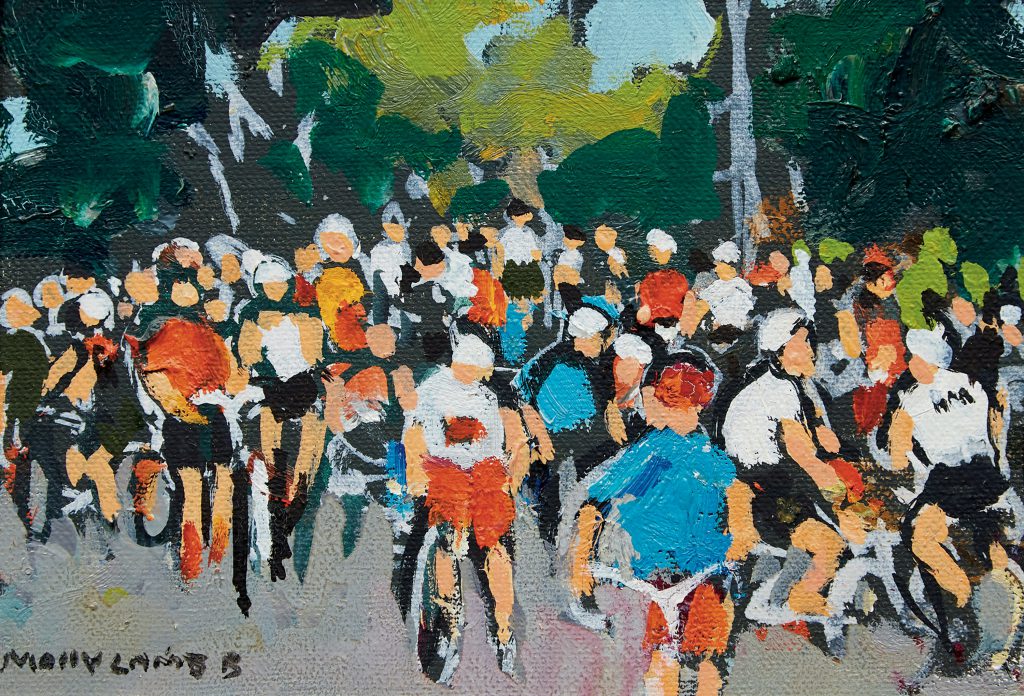
A trailblazer for women in the arts in Canada, Molly Lamb Bobak was an official war artist, stationed in England during the Second World War. Bobak had initially enlisted as a draftswoman in the Canadian Women’s Army Corps (CWAC), documenting the day to day activities of her fellow corps members. Having exhibited at the Canadian Army Art exhibition in 1944, Bobak was awarded a prize for her work leading to her appointment as a war artist between 1945 and 1946.
Bobak often gravitated towards depictions of crowd scenes, as she was inspired by the celebratory victory parades of the Allied Forces at the end of the war. The communal gathering and subsequent energy created in a crowd fascinated the artist and this interest was further explored when Bobak returned to Canada to begin teaching at the University of New Brunswick. Frequenting pubs, sporting events, parades and student rallies, the campus environment offered Bobak ample inspiration and the opportunity to capture the essence of the crowd scene unfolding. “The Bike Race” (lot 2) is a charming work; the canvas captures the movement and frenzy of a bike race, as cyclists round a corner with exaggerated leaning bodies and dots of bright colour stipple the landscape.
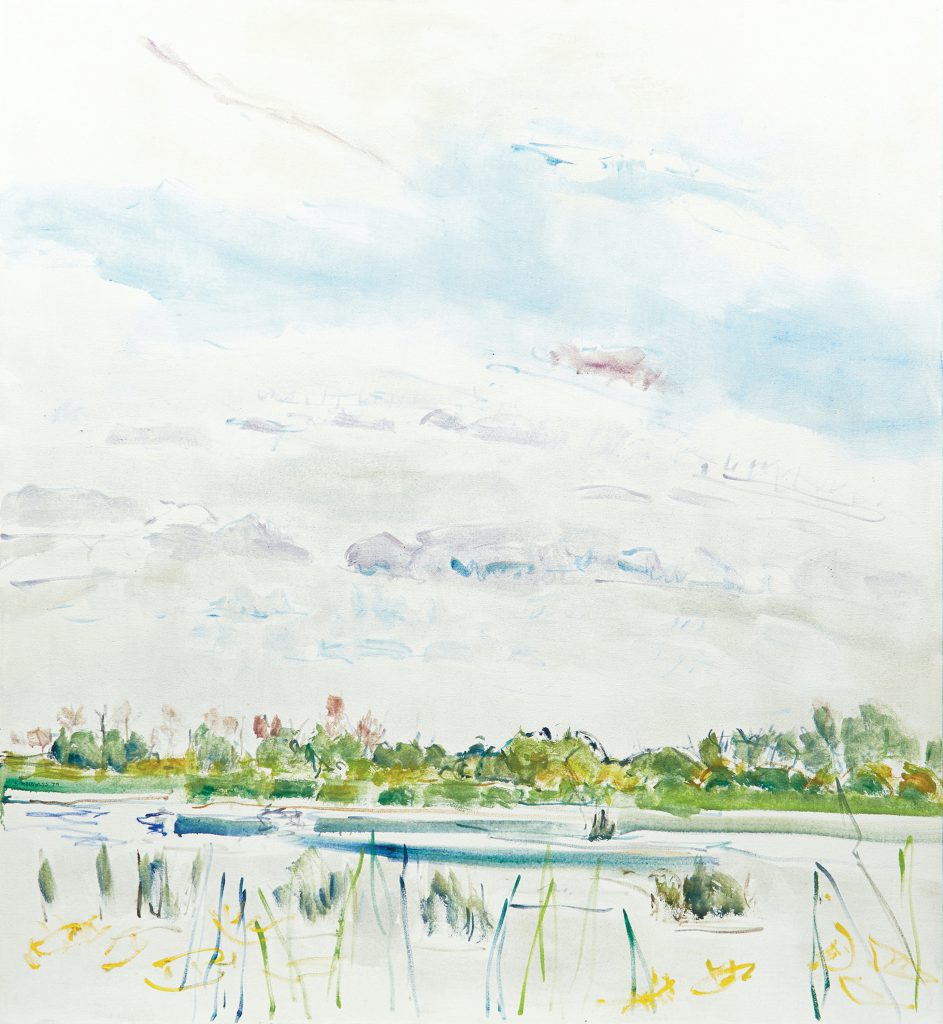
Dorothy Knowles grew up on a farm overlooking a Prairie valley in Saskatchewan and initially had no plans to become a painter, studying biology at the University of Saskatchewan. At the time of her graduation, a friend persuaded her to enroll in a six-week summer course given by the University of Saskatchewan at Emma Lake, where Knowles found a proclivity for art. Her participation in the Emma Lake Workshops in the late 1940s through to the 1960s greatly influenced and encouraged her interest in landscape painting.
In the 1960s Knowles discovered the importance of working directly from nature, while also employing the use of sketches and photographs to finish her work in the studio. Her paintings capture the richness of the Prairie landscape through exploration of colour and texture. In “Reeds” (lot 71), Knowles transmits the diverse natural environment of the landscape. Often associated with paintings of expansive flat fields of wheat, Knowles brings a fresh approach to capturing her native landscape, exploring an impressionistic view of a diverse marshy landscape.
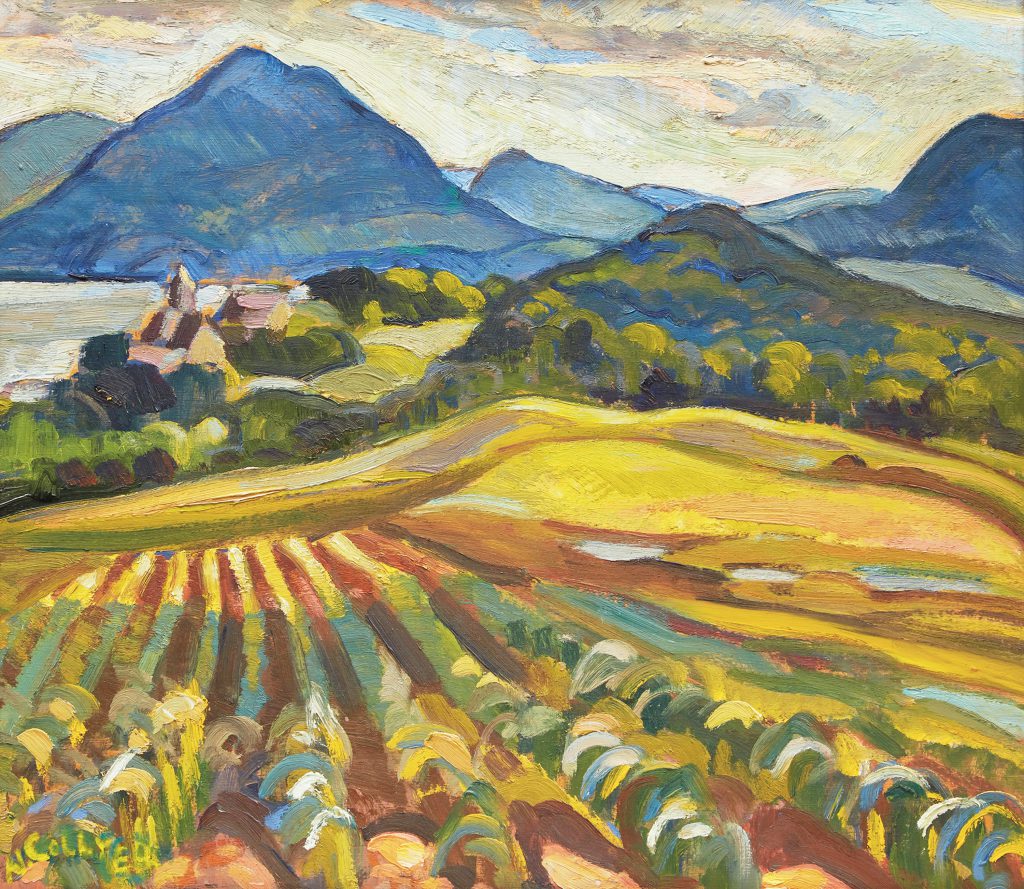
In 1921 Nora Collyer joined fellow Art Association of Montreal graduates at their studio at 305 Beaver Hill Hall. This association of artists called themselves the Beaver Hall Group. The three-story house offered the artists inexpensive studio space and a large room on the ground floor, which served as their exhibition gallery. The Beaver Hall group of modernist painters had a distinctive style rooted in the life and culture of Montreal and Quebec.
Growing up in Montreal with English Protestant parents, Collyer was imbued with a strong sense of community and gravitated towards depicting village landscapes and tokens of rural communities. With a richly composed foreground and a distant village depicted by the shore, “Summer Landscape” (lot 68) is executed with bold colour and rhythmic form, expressing her love of the region.
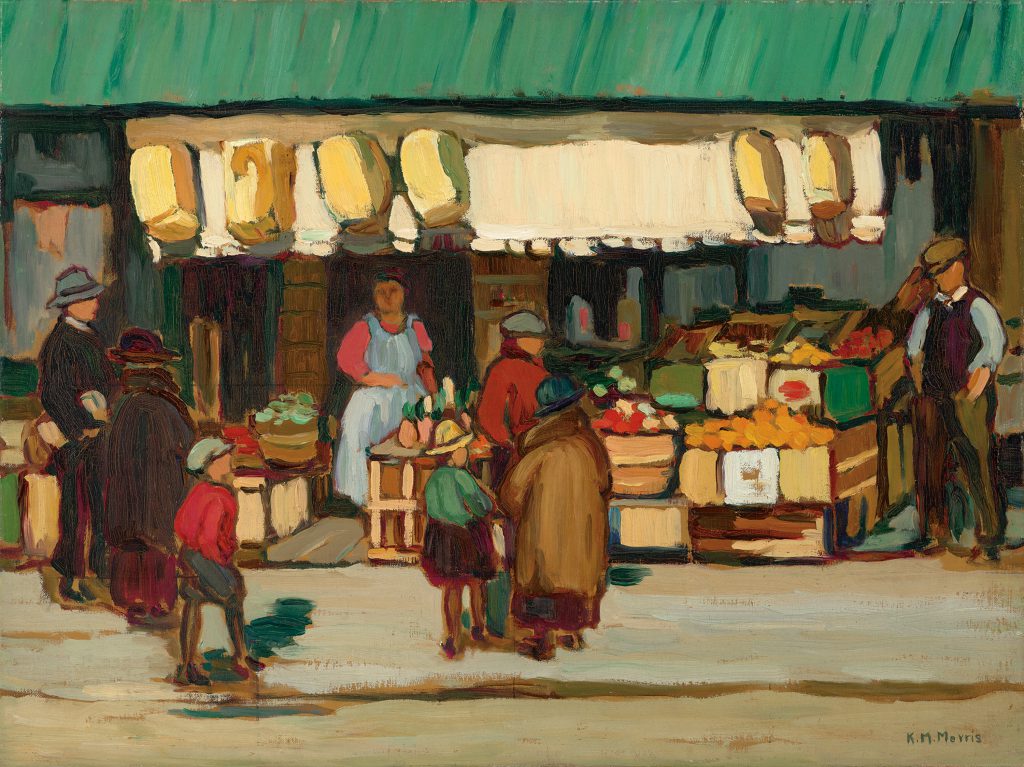
Kathleen Moir Morris studied under William Brymner and Maurice Cullen at the school of the Art Association of Montreal, and became a prominent member of the Beaver Hall Group in 1920. Working in oil, her subjects include landscape, genre, street and market scenes, as well as cabstands throughout Montreal and its environs. Morris was born with a physical disability, but refused to let it prevent her from painting outdoors in all seasons. After her father passed away in 1914, Morris moved to Ottawa with her mother a few years later, residing in a house on O’Connor Street from 1922 to 1929. The painter maintained an active presence in the Montreal art scene while living in Ottawa, continuing to participate in Beaver Hall exhibitions as well as those of the Canadian Group of Painters.
Morris would have frequented the Byward Market, still a bustling and popular destination to this day. In “The Fruit Shop, Ottawa” (lot 17), she depicts the sun shining on a fruit stand, busy with market goers in stylish 1920s attire. The crates of produce are colourful and warmly lit, as is the teal awning framing the upper border of the composition. Morris chose a bright and modern palette, synonymous with her body of work and that of the Beaver Hall Group. She painted from sketches, in which she simplified the forms and applied colour in bold, thick patches, visible in the faceless figures and abstracted fruit and vegetables.
Laura Muntz, born in Warwickshire, England, and came to Canada as a child with her family to settle on a farm in the backwoods of the Muskoka District. She became a school teacher in Hamilton, Ontario, and in her spare hours took art classes. With money saved from her teaching job she studied for a short time at the South Kensington School of Art, England about 1887. She returned to Canada and spent the next seven years earning money for study in Paris at the Academie Colorossi. Muntz also travelled in Holland and Italy and at the end of seven years returned to Toronto and opened a studio.
Muntz was first exposed to the tenets of Impressionism while undertaking artistic training in Paris from 1891-1898. She then adopted the use of light and open, fluid brushwork in her own compositions. The rich tones of Muntz’s swift brushwork in “Girl with Blue Bowl” (lot 58) creates a sensation of gentleness and warmth, reflecting Muntz’s genuine interest in the aesthetic representation of children. Although sadly childless herself, Muntz lived a life surrounded by children. She was a schoolteacher upon moving to Canada, and later became the caregiver of her deceased sister’s eleven children. Muntz’s depiction of domestic scenes not only reveal a consistent study of her most treasured subjects, women and children, but illustrate the female experience of Canada in the late nineteenth and early twentieth centuries.

Maud was born in South Ohio, a community near Yarmouth, Nova Scotia. Born disfigured with sloped shoulders and her chin resting on her chest, Maud led a confined but happy home life after she quit school at 14. Physical deformity may have been her lot, but even more tragic was the loss of both her parents within two years. Thankfully, an aunt who lived in Digby took her in. There she would later answer a newspaper ad that would determine the course of her life. A man named Everett Lewis wanted a housekeeper for his cottage in Marshalltown. She married him in 1938 at the age of thirty-four and would never travel more than an hour’s drive from her birthplace. Maud gathered images from her happy childhood and limited excursions in a Model T with Everett to paint cheerful images on dust pans, scallop shells and even on her house. They would settle into a routine where Everett enjoyed peddling and haggling over the paintings Maud would love to paint. The happiness she painted first attracted neighbours, then tourists and eventually even international attention. It started with a Star Weekly newspaper article and then a 1965 CBC Telescope program featuring her unique works. Her notoriety began to bloom and orders came in so fast that the paint hardly had time to dry.

The simplicity of Maud Lewis’ paintings, brushed initially with scrounged paint from local fishermen onto ubiquitous green boards and postcards, continue to evoke feelings of innocence, of child-like exuberance as enduring as the spring times she loved to paint. Her works, such as “Three Black Cats” (lot 61) and “Sandy Cove” (lot 62) continue to capture audiences intrigued by everyday scenes as diverse as three black cats, hard-working oxen, whimsical butterflies and harbour scenes.
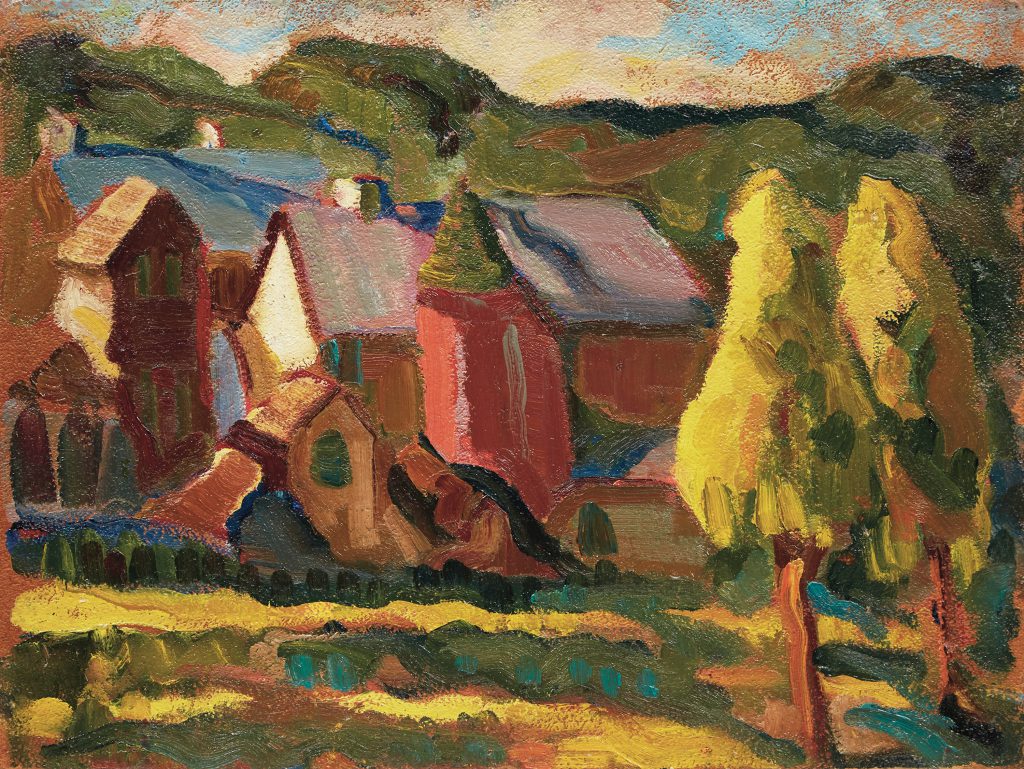
Following studies at the Art Association of Montreal, Mabel May and fellow graduate, Emily Coonan, travelled to France to study. She and Coonan travelled widely in Europe, visiting galleries, museums and sketching, becoming a devote of the Impressionists. Upon her return to Montreal, and with her fellow AAM graduates, May helped establish the Beaver Hall Group in 1920, and in 1933 she became a founding member of the Canadian Group of Painters.
Embracing the francophone tradition of depicting inhabited landscapes, “Farmstead, Eastern Townships” (lot 65) showcases May’s ability to arrange colour to accentuate the weighty mass of the farm structures, while maintaining a sense of lightness in the warm colour palette. Bold strokes of red, ochre and chartreuse imbue the work with warmth, light and vibrancy, highlighting the beauty of the rural scene.

Doris McCarthy – lot 8 and lot 87 images and cataloguing
Born in Calgary and raised in Toronto, Doris McCarthy is recognized as one of Canada’s foremost landscape painters. A teacher at both the Ontario College of Art and Central Technical School, McCarthy spent most of her life living and working in Scarborough, Ontario though she enjoyed many painting adventures across Canada and abroad. In some instances, McCarthy painted on site, and other times she took photographs to refer to later in her studio.

Painting mainly in oils and watercolours, McCarthy developed a personal style that was consistently praised for its vitality, boldness and skillful explorations of hard-edged angles, form and colour. “Two Boats at Barachois” (lot 87) demonstrates this confidence and the aptitude of McCarthy’s brush. McCarthy is probably best-known for her Canadian landscapes and her depictions of Arctic icebergs. In 1972, the year of her retirement from teaching, Doris made her first of many trips to the Canadian Arctic. McCarthy was fascinated with the topography of this territory and the new painting opportunities it provided her. Her paintings of icebergs and the Arctic landscape, including “Iceberg & Floes” (lot 8), are considered to be among the artist’s best known and most celebrated works.



